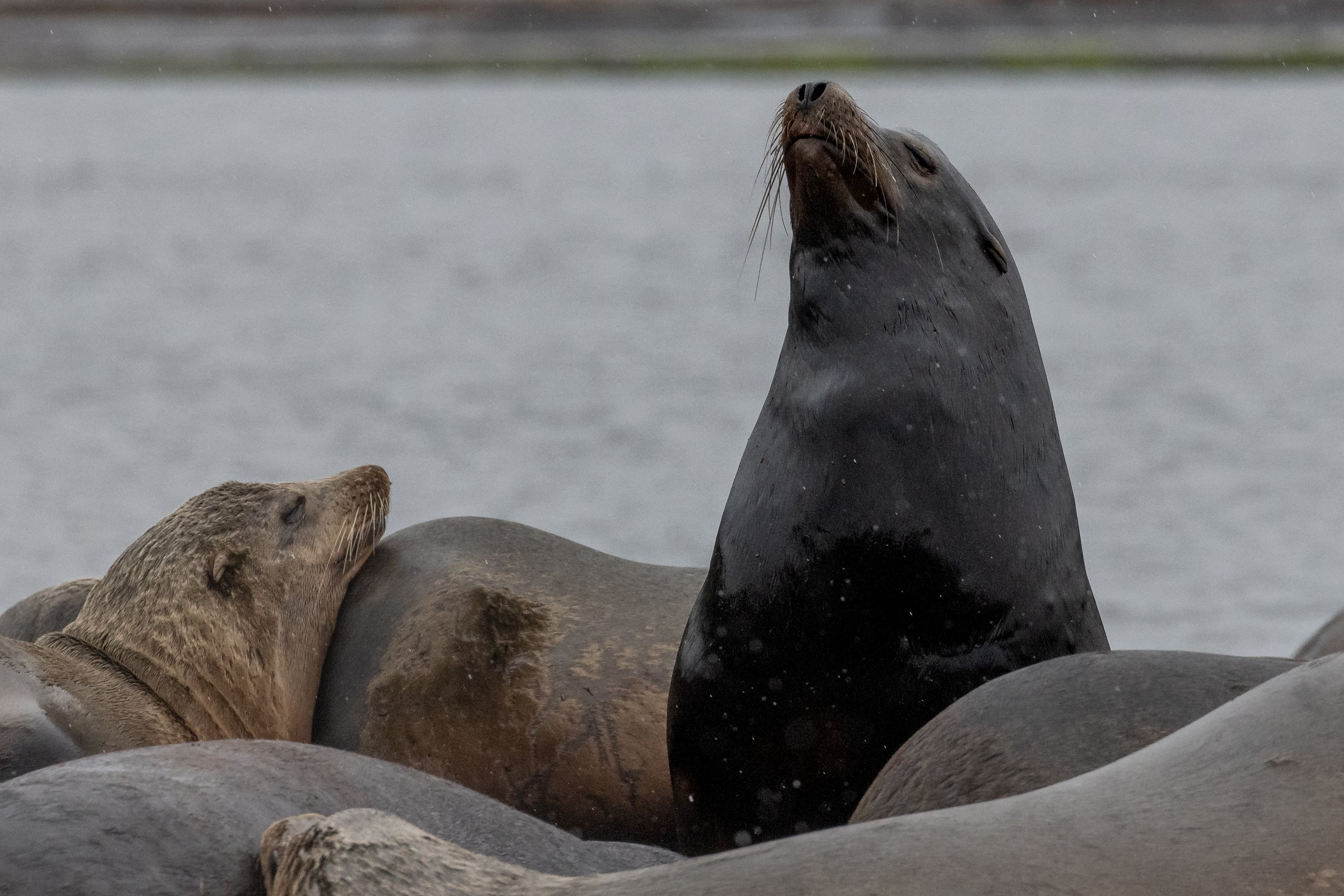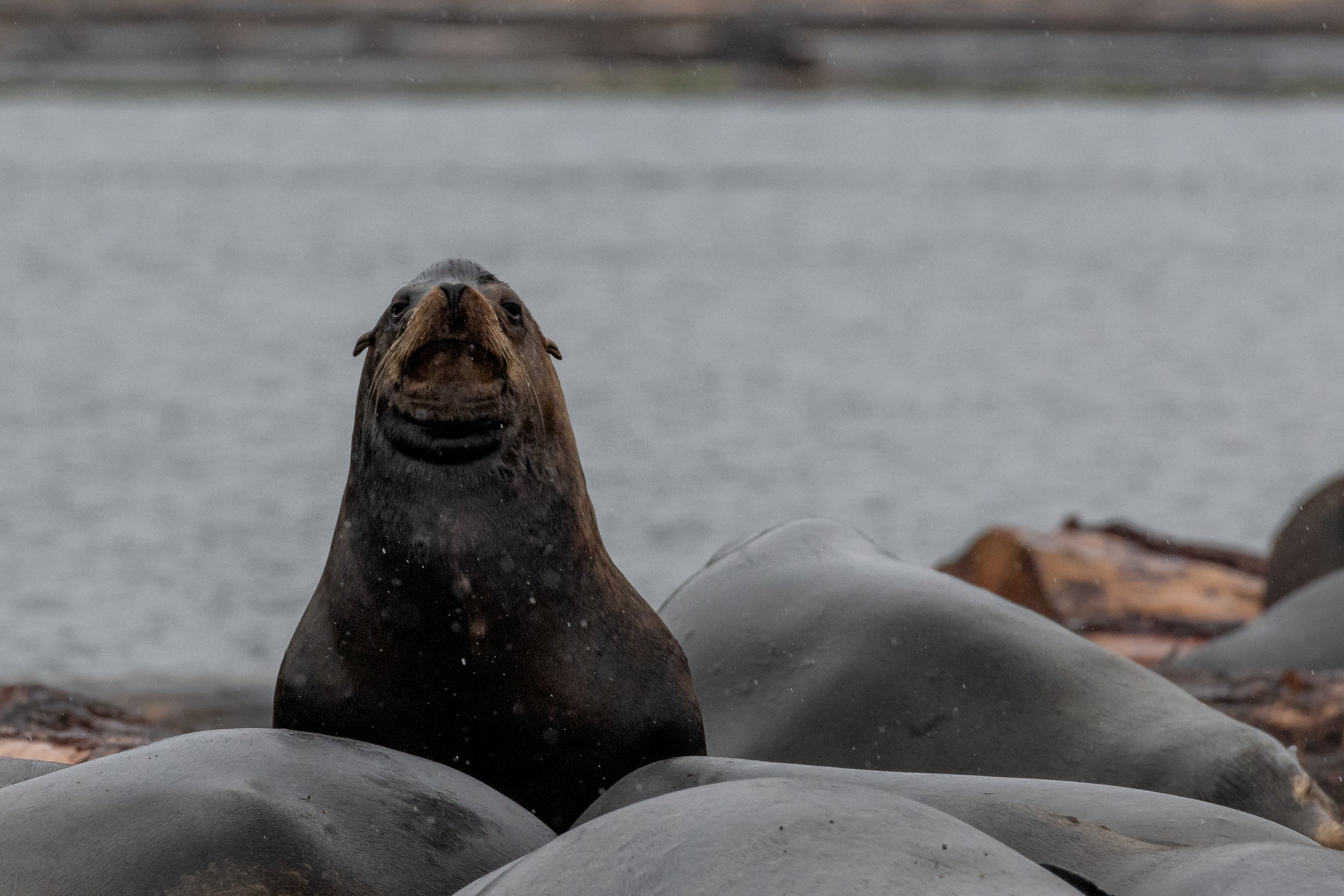May 5, 2023 - Seals, Sea Lions and Gulls, oh my!
It was a cool “June-uary” day in the Salish Sea when our Zodiac, Cascadia, pushed off the dock. We cruised along, searching for whales all along the way. We are very lucky that we have so many different species of plants and animals to see and experience in our own “backyard”, leading to many opportunities to stop and discuss British Columbia’s rich ecosystems.
Our first animal encounter of the day was with a rookery of Harbour Seals snoozing on the shoreline.
Harbour Seals are known for their playful and curious nature, often popping their heads up out of the water to observe their surroundings. They are typically found in coastal areas, such as rocky shores, estuaries, and bays, and can sometimes be seen basking on rocks or sandbars during low tide.
One of the most distinctive features of Harbour Seals is their spotted coat, which can range from gray to brown to black. They are also known for their large, dark eyes, which are specially adapted to see in low light conditions underwater.
Harbour Seals are a vital part of the Pacific Northwest ecosystem and are an important indicator of the health of the marine environment, as they are particularly sensitive to changes in water quality and pollution.
We were also able to locate both of our local sea lion species today: the Steller sea lion and the California Sea Lion. Do you know how to distinguish these two species?
Steller sea lions (Eumetopias jubatus) are the larger species, with adult males reaching up to 11 feet in length and weighing over 2,000 pounds. Females are smaller, typically reaching about 9 feet in length and weighing around 600 pounds. Steller sea lions are known for their golden-brown colour and thick fur, which helps to keep them warm in the cold Pacific waters.
In contrast, California sea lions (Zalophus californianus) are smaller, with adult males reaching up to 8 feet in length and weighing around 800 pounds. Females are even smaller, typically reaching about 6 feet in length and weighing around 200 pounds. California sea lions are known for their dark brown colour and sleek, slender bodies.
Another big difference between these two species is their behaviour. Steller sea lions are known for their loud rumbly vocalizations and boisterous personalities. They are often seen lounging on rocky shores or floating on the surface of the water. California sea lions, on the other hand, are more social and playful. They are often seen barking and playing with one another and can frequently be spotted riding waves and surfing along the coastline.
Besides our pinnipeds, we also spotted a large flock of Bonaparte’s Gulls bobbing along the surface of the water. Despite their diminutive size, Bonaparte's Gulls are known for their striking appearance. During the breeding season, they have a black hood that extends down to their chest, with a white triangle on the side of their head and a light gray back. Outside of the breeding season, their head becomes white with a gray smudge behind their ear. They are also easily identifiable by their slender bill and long, pointed wings.
Bonaparte's Gulls are known to breed in the boreal forests of Canada. Though usually found near freshwater sources such as lakes and rivers, we regularly find them in the narrow passageways of the Southern Gulf Islands.
One of the most interesting things about Bonaparte's Gulls is their foraging behaviour. Unlike many gulls, they feed primarily on small fish and insects, which they catch by hovering over the water or diving down to the surface. They are also known to feed “on the wing”, snatching insects out of the air as they fly by.
Any whales we encounter on our trips are completely free of any kind of trackers or tags. Sometimes, that means we are unable to locate whales on a tour - today was one of those days. Our guests received vouchers to join us for another tour at their leisure so we can show them our whales (and other interesting animals) in the future!
Photos by Marine Naturalist Val Watson.
Harbour Seals or the Happy Little Rock Sausages :)
Harbour Seal on the left appears to be watching us back.
This one too.
Looks comfortable!
The large Stellar Sea Lion surfacing.
Check out those whiskers! They are used to sense vibration helping Sea Lions find prey.
Giving the side eye.
Gulls hanging out.
One of these Gulls is not like the other.
Bonaparte’s Gull.
Bonaparte’s Gull stretching out those wings.
Looks like it may have spotted a snack!
Bonaparte’s Gulls.
We’ll go this way, you go that way.
It’s a bird, a plane, a rabbit?
California Sea Lions.
Look at me!
Can you see the lighter coloured sagittal crest?
I see you!
Criss cross.
A cuddle puddle of California Sea Lions.
Here’s looking at you!

























